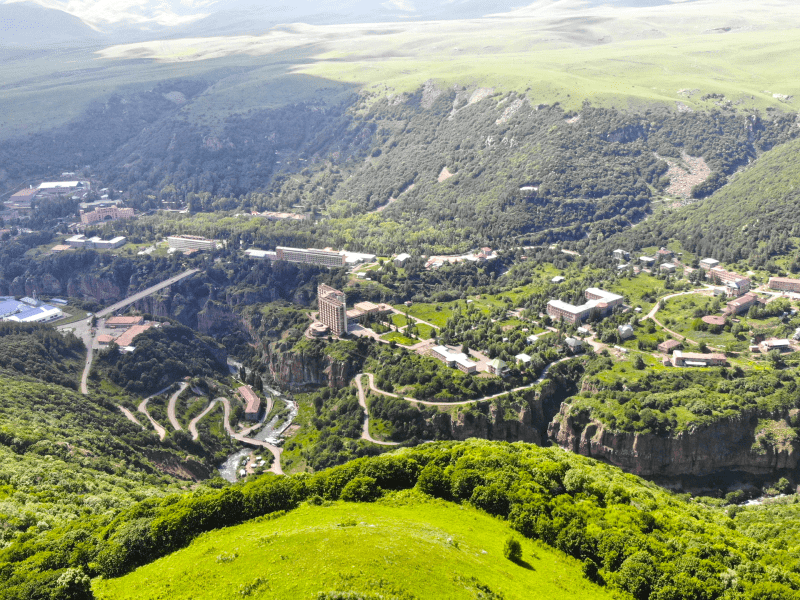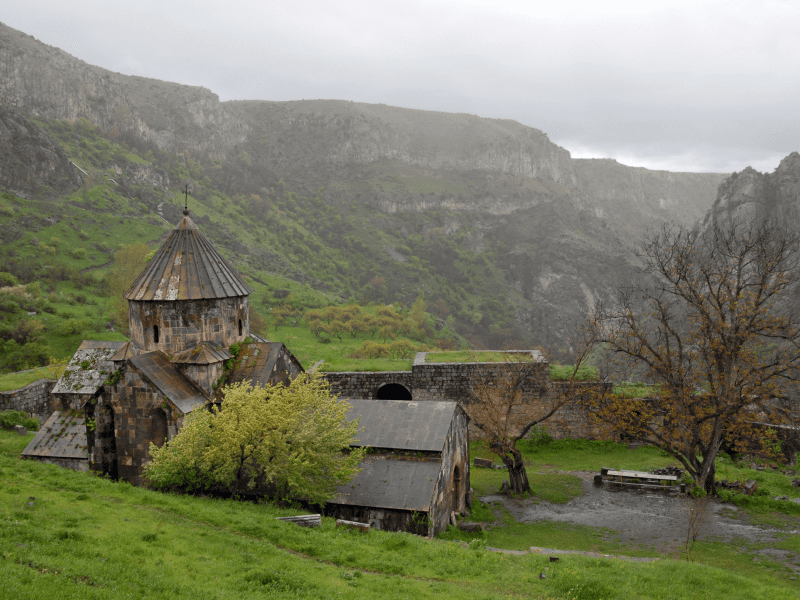Jermuk
Weather and climate
In the picturesque embrace of the Arpa gorge stands the town and balneological resort of Jermuk. Here, alpine meadows unfold next to rich woods, and River Arpa flows through the town, forming beautiful cascades of waterfalls. Time moves in sync with nature here, enabling people to stop in their tracks, look into what’s around them, and feel the complex taste of life.
The history of Jermuk
There is a legend about the foundation of Jermuk. Many years ago, a hunter wounded a strong, beautiful stag in the woods. The animal rushed towards a spring and threw itself into the bubbling water. Some time later, the stag emerged completely healed, without a trace of the wound. The miraculous healing of the stag stunned the hunter, and he decided to found a town where the spring was. As for the stag, the animal that showed people the secret of the miraculous water became the town’s symbol. To this day, the town of Jermuk has a stag on its coat of arms as well as on the logo of “Jermuk” mineral water company.
“Jermuk” translates from Armenian as “warm”. The name reflects the reality: the town has over 40 cold and hot thermal mineral springs, whose water is renowned for its healing properties. Local mineral springs are mentioned in manuscripts dating back as far as I century BC. The water of Jermuk has always been an efficient remedy against various illnesses. People traveled over high mountains just to take a healing bath in Jermuk’s ponds. The remains of stone pools in the town present the evidence for the fame and popularity Jermuk has enjoyed for centuries.
The Soviet authorities heard of Jermuk’s wonder springs too. In 1925, it sent the first Soviet scientific expedition to study the healing properties of springs in Jermuk. Based on the results of the study, the Soviet authorities decided to create a balneological resort in Jermuk. Spa retreats and medical facilities were built in the town, and Jermuk became a popular resort for the entire Soviet Union. Soviet leadership and elite visited Jermuk to stay at the retreats, so local people grew used to the sight of helicopters, and the whole town was filled to the brim with tourists eager to restore their health with the help of Jermuk’s mineral waters.
Jermuk today
Jermuk is a charming mountainous resort. There are only 6,000 residents, but the tourist flow is always large. The town is divided into the living and the tourist areas. In the latter, there are a multitude of hotels ranging from well-known chains to small, cozy hostels, as well as top-class spa retreats. Restaurants in Jermuk offer both Armenian and international cuisine. The living area of the town is another town on its own, small, but equipped with all necessary infrastructure. Jermuk also has several factories producing “Jermuk” mineral water, and the oldest one was founded in 1951. From here, mineral water is delivered in bottles nationwide and abroad.
The sights
Mineral Water Gallery
The main tourist attraction of Jermuk is its mineral water. Its properties are equal to those of Karlovy Vary (Czech Republic). “Jermuk” water is used for drinking, bathing, in the treatment of diabetes and many other illnesses.
You can try Jermuk’s thermal water at the Mineral Water Gallery, one of the town’s most artful spots. The gallery was constructed in 1956 by architect Alexander Tamanian’s son Gevorg Tamanian. It is a graceful structure with arches and columns, built from stone of warm beige color. Drinking water is supplied through pipes into beautiful vessels. The gallery has 5 types of mineral water with different components and temperatures from 30 to 53 degrees C.
The town park
The perfect place to walk leisurely, breathe in the fresh mountainous air, and enjoy local nature is the town park, at the heart of which lies a small lake. The park also has an abandoned building of a theater, built in the Soviet era, with an impressive high relief on the façade. There are also statues of famous fedayi fighters, sculpted by Hovhannes Muradyan. Fidai were Armenian militia formed from ordinary people, who volunteered for self-defense units. The fedayi units emerged as a reaction to the mass killings of Armenians in the Ottoman Empire in ХIХ – ХХ centuries. Obviously, there was also a larger mission for these people – obtain autonomy and then full-fledged independence for the Armenian people.
The Jermuk waterfall, or “Maiden’s braids”
One of Armenia’s most beautiful waterfalls rolls down the southern slope of the Vardenis mountain range. The Jermuk waterfall is a wondrous natural phenomenon. Water rushes down in a powerful stream, creating huge amounts of white foam on the landing, which flows down the rock.
The waterfall got its second name from a local legend. Once upon a time, a young maiden from a noble family lived in a house on the hill. She fell in love with a shepherd, and every night she let down her hair for her beloved to climb up to her. However, when the maiden’s father learned of that, he cursed her: if she met the shepherd one more time, she would turn into a mermaid. The daughter disobeyed her father. She let down her hair and turned into a mermaid immediately, and her hair flew down the rock as a waterfall.
Gndevank monastery
Gndevank monastery was built in 936 on the left slope of River Arpa’s gorge, near the village of Gndevaz. According to historical sources, it was erected on the initiative of Princess Sofia of Syunik for monks and named after monk Supan Gnduni. The monastery complex includes the cells of senior priests, the canteen, and several utility rooms. The church is surrounded by a defense wall. The complex also includes khachkars and gravestones of X–XIII centuries. The monastery is still active today and inhabited by hermits.
Kechut water reservoir
At the distance of 4km from Jermuk stands a water reservoir that was built to regulate the water resources of Lake Sevan. The reservoir is filled by River Arpa and atmospheric precipitation. Sometimes the Kechut reservoir is called “daisy” because of the tunnel that looks like a 6-petal flower. Next to the reservoir, in the gorge of River Apra, you can find the stone of Vardan Mamikonyan – a natural phenomenon included in the list of Armenia’s state natural monuments.
The cultural aspect
The cultural field is represented in Jermuk by the Jermuk Gallery, a branch of the National Gallery of Armenia. There, you can see the works of prominent modern Armenian artists: M. Saryan, V. Gayfejyan, A. Kalents, H. Hakobyan, M. Petrosyan and others. The gallery also has sculptures. In total, there are around 100 works displayed. The gallery regularly organizes exhibits, lectures, and master classes.
What to combine with a trip to Jermuk
Jermuk is located in the southern part of Armenia, in a 3-hour drive from Yerevan. On the way to the resort town, you can visit some sights of the south of the country.
The first stop we recommend is the Khor Virap monastery, which is one of the most cherished Christian structures in Armenia. The monastery stands at the foot of Mount Ararat. It is considered the birthplace of Christianity in the country, and rightly so. Then, you can travel to the village of Areni, which is possibly the birthplace of winemaking in Armenia. Archeological digging in one of local caves uncovered a winemaking complex that is no less than 6,100 years old. The archeological team also discovered in the caves the tools for winemaking, as well as vines, and vessels with remnants of wine. All that gives Areni discovery the status of the oldest winery in the world.
As you travel further south, you will see Tatev, one of Armenia’s most magnificent and important religious sights. This impressive monastery complex was founded in the IX century in the Syunik province. For centuries, Tatev has been the spiritual and educational center of the country. In addition to exceptional architecture, the complex has a wonderful location as well: Tatev stands high in the mountains, so you will get a splendid view wherever you stand – all of Tatev is surrounded by gorgeous mountains and stunning gorges.
There was a sending error, try refreshing the page and sending again.
Thanks! The manager will contact you soon.


